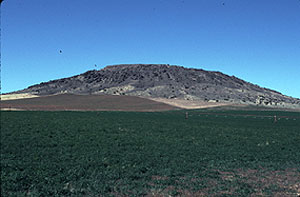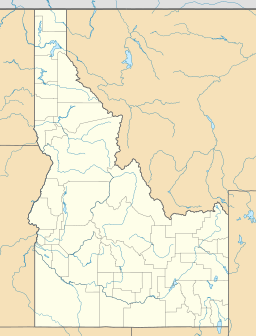Menan Buttes facts for kids
Quick facts for kids Menan Buttes |
|
|---|---|

North Menan Butte
|
|
| Highest point | |
| Elevation | 5,619 ft (1,713 m) |
| Geography | |
| Location | Madison / Jefferson counties, Idaho, United States |
| Topo map | [1] |
| Geology | |
| Age of rock | late Pleistocene, approximately 10,000 YBP |
| Mountain type | tuff cones |
| Designated: | 1980 |
The Menan Buttes are two huge volcanic hills in southeastern Idaho. They are among the biggest "tuff cones" in the world. A tuff cone is a special type of volcano. These two main cones, along with four smaller ones, form what is called the Menan Complex.
These buttes rise about 800 feet (250 meters) above the flat land around them, which is part of the Snake River plain. They were formed a very long time ago, about 10,000 years ago, during the late Pleistocene Ice Age.
One of the buttes, South Menan Butte, is privately owned. However, North Menan Butte belongs to the public. It has been named a National Natural Landmark and a Research Natural Area by the United States Congress. The US Bureau of Land Management also calls North Butte an Area of Critical Environmental Concern (ACEC). This means it's a special place that needs to be protected.
How the Menan Buttes Formed
The volcanoes that created the Menan Buttes were formed in a unique way. Hot, melted rock called basaltic magma came up from deep underground. This magma then hit a shallow underground water source, like an aquifer, or perhaps an older version of the Snake River.
When the super-hot magma touched the water, the water instantly turned into steam. This caused a massive, explosive eruption! Tiny pieces of volcanic glass, called tachylite, were created during this explosion.
The material that erupted settled into cone shapes, forming the buttes. These deposits are mostly made of "tuff," which are small, rock fragments. Some layers of rock even show "bomb sags." These are dents made when larger pieces of rock landed on the soft, fresh tuff layers.
Size and Shape of the Buttes
The Menan Buttes stand at an elevation of 5,619 feet (1,713 meters) above sea level. Both buttes are very similar in their size and shape.
North Menan Butte is a bit larger. It's shaped like an oval, about 3.5 kilometers (2.2 miles) long and 2.5 kilometers (1.6 miles) wide. South Menan Butte is also oval, measuring about 3 kilometers (1.9 miles) by 2 kilometers (1.2 miles).
The crater at the top of North Menan Butte is about 3,000 feet (900 meters) across. The base of the cone is about 6,000 feet (1,800 meters) wide. North Butte holds about 0.16 cubic miles (0.70 cubic kilometers) of material. South Butte is smaller, with about 0.07 cubic miles (0.30 cubic kilometers) of material.
To give you an idea, the famous tuff cone Diamond Head in Oahu, Hawaii, has a volume of about 0.15 cubic miles (0.6 cubic kilometers). This shows how large the Menan Buttes really are!
The larger buttes in the Menan Complex are not perfectly symmetrical. They have more material piled up on their northeast side. Scientists believe this happened because strong southwest winds were blowing during the eruption. These winds pushed the volcanic ash and rock to one side as it fell.
Where to Find the Buttes
The Menan Buttes are mainly located in Madison County, Idaho. Their lower slopes also reach into Jefferson County.
Some nearby towns and communities include Menan, Rigby, Rexburg, and Idaho Falls, Idaho.


